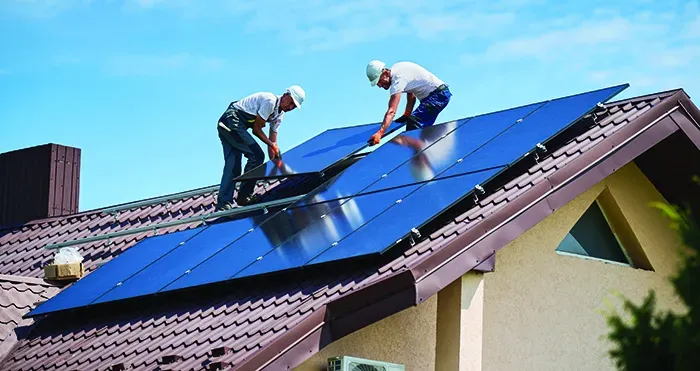Shutterstock / Anatoliy_Gleb
As floods, heatwaves and storms become more frequent, the need to build climate resilience into new homes and to retrofit existing housing stock is getting more urgent.
Analysis from JBA Risk Management reveals that one in four UK properties is at flood risk, with an estimated annual cost of £527m to residential properties from flooding alone.
Meanwhile, Nationwide Building Society data shows significant variation in energy efficiency across different property types, with only 49% of owner-occupied homes rated A to C — the government’s minimum target for energy efficiency in the coming decade — compared to 72% in the social rented sector.
If we do this properly, we can also protect asset values, reduce the risk of arrears and even create space for greater innovation from lenders
Overheating is also a growing problem, with the number of UK homes becoming uncomfortably hot in summer quadrupling to 80% over the past decade, according to a study by Dr Mehri Khosravi at the University of East London’s Sustainability Research Institute.
The report highlights that, in the heatwaves of 2022 — when temperatures soared above 40°C for the first time on record — there were 4,500 excess deaths in the UK, but that heat-related mortality is often hidden in statistics about heart attacks, strokes and respiratory conditions.
The research also found a sevenfold rise in air-conditioning use, now installed in more than 21% of UK homes. But Dr Khosravi cautioned that this trend could put additional strain on the national energy grid and worsen social inequality as those on a low income might be unable to afford cooling systems.
Decarbonising stock
It is no surprise, then, that the verdict from the Climate Change Committee in its progress report this year was damning: Britain’s preparedness for the extreme weather challenges that lie ahead is “inadequate”.
Nationwide senior economist Andrew Harvey agrees that urgent action is needed.
He says: “Decarbonising and adapting the housing stock are critical if the UK is to meet its 2050 emissions targets, especially given that emissions from residential buildings account for 15% of the country’s greenhouse gas emissions.”
Successful passive homes are healthier, more comfortable and more efficient
Achieving meaningful change will require policymakers, housebuilders and lenders to pull together. Ecology Building Society senior mortgages product and proposition manager Daniel Capstick believes it also means embracing the solutions that are available now rather than waiting on the sidelines for the next development.
“Waiting for ‘perfect’ is like refusing to buy a smartphone until 6G arrives,” he says.
“The fastest route to cutting the carbon footprint of many homes today is to electrify heating and generate clean power now, while ensuring properties are ready for future upgrades to their fabric. That goes for new-builds as well as existing properties.
“Technology is outpacing the speed at which we can deep retrofit the UK’s 29 million homes, so we need to use what is available now.
Heat pumps are becoming more efficient, solar panels and battery systems are becoming cheaper and smarter, and the decarbonisation of the National Grid is accelerating.”
However, even as the technology improves at a pace, the rate of take-up by households is slow. Interventions are expensive and there are often practical obstacles depending on the type of property, the plot of land it sits on and the location.
Many retrofit measures risk becoming the defects of the future
Harvey explains: “Low-carbon technologies such as air-source heat pumps are expected to play a greater role in future. However, these are currently quite a rare feature, with only 276,000 dwellings in England using a heat pump as the primary heating system — just 1.1% of total stock.
“Uptake is higher in rural areas at 7.6%, compared to 0.5% in urban areas, reflecting more limited access to mains gas networks.”
Uptake of solar power is further ahead, but still far from universal, Nationwide found.
“There is a much wider uptake of solar panels, with 1.5 million dwellings in England having photovoltaic [PV] panels — nearly 6% of dwellings,” says Harvey. “Over 15% of properties built in the past 10 years have PV.”
Another fast-growing sustainability feature is electric vehicle (EV) charging.
“1.8 million dwellings have access to an EV charge point — around 7% of the total stock,” says Harvey. “For newer homes built post-2012, this rises to about 20%.”
There have been cashback products, but the cashback is often factored into the cost of the loan, so it doesn’t end up as a reward
Ensuring that homes are fit for all seasons, while remaining properly ventilated, is another conundrum.
“Airtightness and insulation still matter hugely,” says Capstick, “and we must make homes more resilient to the challenges brought by climate change.
“The UK’s ageing housing stock has led to a lot of focus on keeping properties warmer but this summer’s hot, sunny weather is a reminder our homes need to be liveable and comfortable in different climatic conditions. Design can help with this and some heat pumps can be used to cool homes too.
“The government can help by continuing its grant support for green home improvements, while providing better public education and trusted accreditation for suppliers would give homeowners greater confidence in their choices.”
Low-carbon technologies such as air-source heat pumps are expected to play a greater role in future
Love Surveying founder Marion Ellis agrees that homeowners need more support as they seek to update their homes.
“Retrofitting existing homes is far more complex than people think.
Many retrofit measures risk becoming the defects of the future. Consumers are caught in the middle, as past failures, such as poor cladding and spray foam, have damaged confidence.”
Modern materials
With new homes, modern materials can have huge benefits in improving insulation and speeding up delivery, but caution is required, Capstick argues.
“Poor-quality housing built in previous generations sometimes ended up being replaced within a few decades, so we must ensure we’re building homes to a high standard so they can remain in good condition and in use for longer,” he says. “As a lender, we support non-standard construction materials and techniques, and we would encourage more lenders to be open on this where it can be shown to have environmental and practical benefits.”
Harvey Donaldson & Gibson, part of Countrywide Surveying Services, also advocates wider uptake of new building materials.
Consumers are caught in the middle, as past failures, such as poor cladding and spray foam, have damaged confidence
Operations director Jonathan Shaw says: “Modern methods of construction are particularly prevalent in passive housebuilding, which is often seen as the ‘gold standard’ of sustainable housebuilding. Not only can they lower operational emissions but these forms of construction can reduce the carbon footprint during construction and often reduce build times.
“Successful passive homes are healthier, more comfortable and more energy efficient, reducing heating and cooling needs by up to 90%.”
As well as flexible lending on these types of building innovations, green mortgages that incentivise energy-efficient improvements are often touted by politicians and the industry. But some feel the products have yet to drive substantial change in the behaviour of borrowers because the discounts are not significant enough.
Shaw says: “Green mortgages are a good start, but we need to go further: offering preferential rates or enhanced affordability assessments for energy-efficient homes; ensuring borrowing for green measures is spent on those measures; and recognising long-term savings from low-energy living in lending decisions.”
Heat pumps are becoming more efficient, solar panels and battery systems are becoming cheaper and smarter
MSP Financial Solutions director Chris Sykes says: “Quite a few lenders have ranges where they reward properties specifically with an A or B rating; some do A–C.
But this is a lazy way of improving the book to meet government targets — it doesn’t improve the housing stock, it just concentrates on existing homes.
“Rewarding those who improve is arguably more important. Halifax, for example, has a scheme where, if you’ve completed energy-efficient works within a year of taking the mortgage, you can claim up to £2,000 cashback.”
But many schemes fall down in practice.
“There have been cashback products, but the cashback is often factored into the cost of the loan, so it doesn’t end up as a reward,” says Sykes.
“Other offers, like Nationwide’s interest-free additional borrowing, require a full application and income assessment, which most clients find too much hassle.”
Even when the products work, borrowers often feel that the upfront cost of renovations takes too long to recoup.
“Halifax has a good online calculator, but sometimes it highlights that the works aren’t worth doing because you spend £5,000 to save £50 a month. That’s a 10-year payback, and you may not be in the property by then,” says Sykes.
Decarbonising and adapting the housing stock are critical if the UK is to meet its 2050 emissions targets
“The cost is often the sticking point, and they don’t always feed into higher property values.”
The founder of specialist green mortgages broker Lenderhive, James Armitage, believes we need a step change to make climate-resilient housing a reality. He wants mortgages of the future to provide buyers, lenders and communities with confidence that homes are fit for the challenges ahead.
“We need to recognise that this isn’t just about sustainability.
If we do this properly, we can also protect asset values, reduce the risk of arrears and even create space for greater innovation from lenders.”
This article featured in the September 2025 edition of Mortgage Strategy.
If you would like to subscribe to the monthly print or digital magazine, please click here.
Disclaimer: This story is auto-aggregated by a computer program and has not been created or edited by finopulse.
Publisher: Source link








